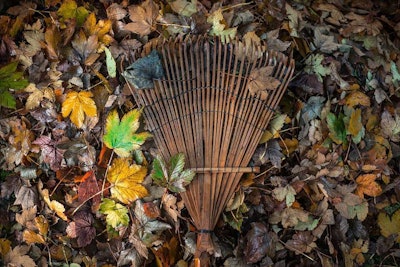
Fall is a perfect time to work on boosting your client’s soil, as the organic material will have all winter to break down and help prime the soil for planting in the spring.
Soil is full of living things and needs certain minerals and nutrients for plants to thrive, so don’t forget to conduct a soil test before determining what method should be taken to improve it.
Mulch leaves
Blowing or raking leaves only to throw them away is a complete waste of money, so be sure to let your clients know they can get a little extra out of their discarded foliage.
If there is just a light layer of leaves on the lawn, offer to mow it, as this will allow the turf to get the air circulation it needs, and the leaves can break down faster in smaller pieces.
For more considerable piles of leaves, go ahead and mulch these up as well to use in 2- to 3-inch layers in planting beds and around trees and shrubs.
A shredded pile of leaves can help retain moisture and protect the microscopic organisms in the soil, while returning phosphorous and potassium to the soil. Adding some slow-release nitrogen fertilizers with the shredded leaves in the soil will speed the decomposition and keep microbes from using all the nitrogen.
Compost leaves
Composting is generally a practice that can be shrouded in mystery for the uninitiated, but it is a simple chore that boasts of many benefits, and a key one is the black gold it produces.
Fall is a great time to start composting because of the abundance of carbon-rich leaves, also known as “browns.” Composting basically consists of a balance between carbon and nitrogen. For 6 to 8 inches of leaves, you’d want 1 inch of soil, and 1 inch of manure or another “green” such as grass clippings.
The decomposition process may slow during the winter but the microbes are still actively working away. It is best to shred both browns and greens before adding them to the pile, and to turn the pile less frequently than in the summer to prevent heat from escaping.
Cover crop
For those living in an area with moderate winters, a cover crop can be used to return nitrogen to soil. Red clover, legumes and many cereal grains can be used as “green manure.”
Their growth can reduce soil compaction and erosion while drawing in nitrogen from the air and fixing it in the soil for next year’s plants.
“The one problem is our soils are carbon-depleted, so we need to get more carbon into the soil. That’s where utilizing cover crops is very important. That cover crop feeds billions of organisms. They need a diverse diet,” says Kris Nichols, chief scientist at the Rodale Institute, in an interview with Cool Green Science.
Cover crops should be planted early enough to allow for four weeks of growth before cold winter stops growth. In the spring, the cover crop should be mowed before it can go to seed and then tilled into the soil.
Wait at least three weeks for the cover crop to decompose before using the bed for spring planting.









